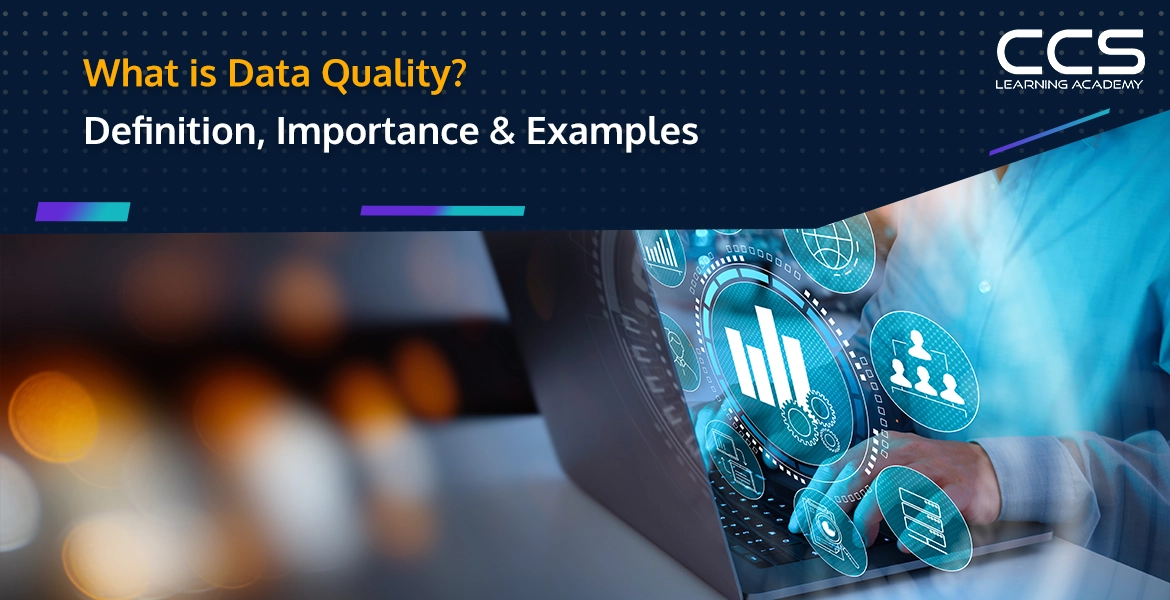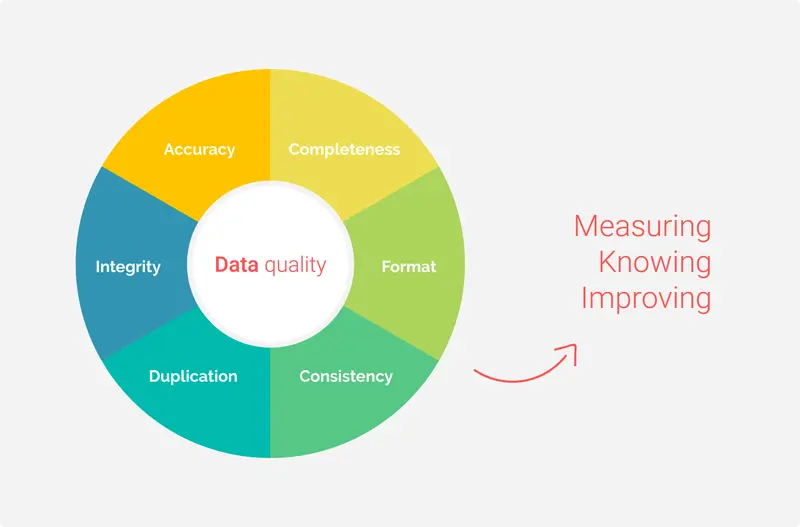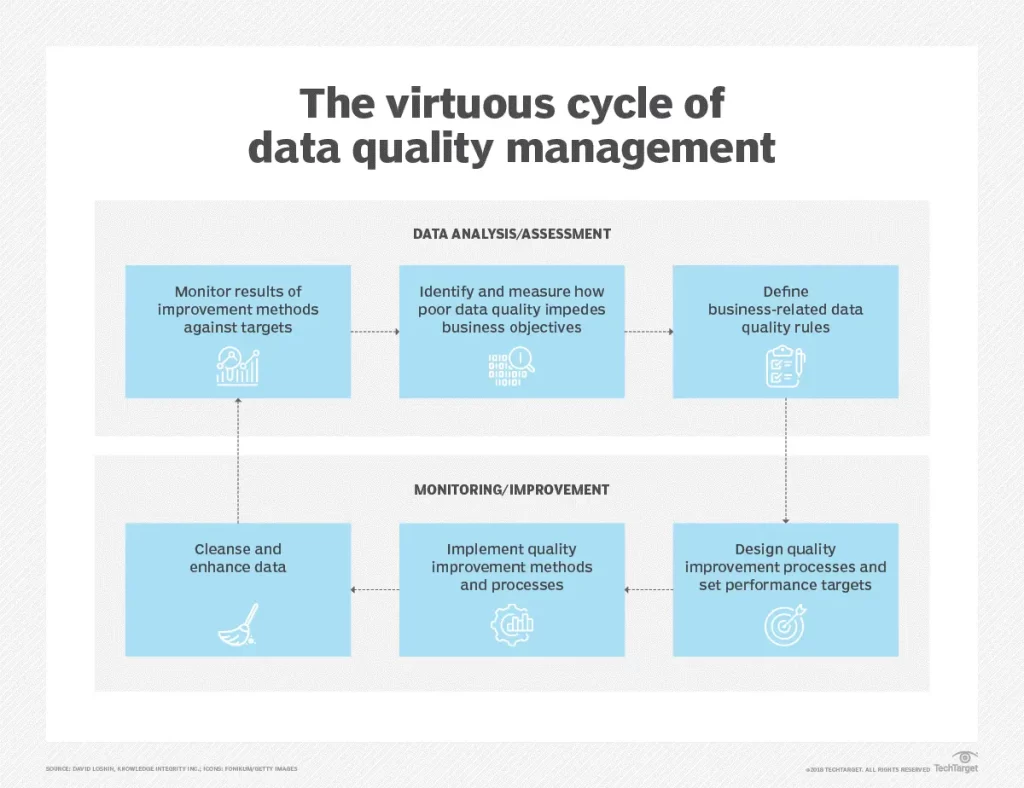What is Data Quality? Definition, Importance & Examples
- -
- Time -

In today’s digital world where data drives business decisions, the quality of data has become more important than ever before. But what exactly is data quality and why should organizations care about it? This article aims to provide a comprehensive understanding of data quality – its definition, importance, dimensions to measure it, challenges to data quality and steps to improve it with relevant examples.
What is the Definition of Data Quality?

Simply put, data quality refers to how well suited a particular dataset is for its intended purpose or use case. High-quality data is complete, accurate, consistent, available, usable and secure.
Data quality is a measure of how error-free and reliable certain data is. It indicates how well the data represents the real-world objects, events or scenarios it intends to describe.
For data to be of high quality, it needs to match the real world from which it was collected as closely as possible. Any deviations, inaccuracies, gaps or inconsistencies deteriorate the quality of data.
Dimensions to Measure Data Quality
Data quality assessment is a process that organizations undertake to evaluate their datasets based on standard dimensions. Understanding these dimensions is crucial for data management professionals to effectively govern data as a strategic asset.
Data quality experts generally assess data quality based on the following key dimensions:
Accuracy
Accuracy refers to how closely a data value matches the real-world object or idea it represents. Data managers validate accuracy through verifying data points against trusted sources of truth. High accuracy ensures analytics and insights drawn from the data reflect reality. Low accuracy introduces errors that mislead decision-making.
Accuracy challenges arise from outdated data, manual errors, and system flaws. Regular validation checks against source systems help enhance accuracy over time.
Completeness
Completeness measures the presence or absence of expected data values. Incomplete data obscures a full understanding of situations and entities. Common causes of incompleteness include missing attributes, truncated records, and null values left unintentionally blank. Data profiling assesses completeness rates to identify such gaps.
Filling omissions through add/update processes then improves coverage. Completeness directly affects analytic usefulness – the more holistic the data portrait, the better the outcomes.
Uniqueness
The uniqueness dimension checks for identities solely distinguishing entities. Duplicate records that indicate the same real-world item cause reference errors and skew statistics. Deduplication removes multiple references to bring each entity down to a single representation.
Addressing uniqueness especially matters for integrated views across multiple source systems. De-duplicated data avoids double-counting and ensures one-to-one mappings.
Timeliness
Timeliness evaluates data freshness relative to business cycle timeframes. Stale values hamper accurate decision-making as situations evolve. Regular updates maintain relevance over the data lifetime. Lack of timeliness arises from infrequent or missing change data captures from operational sources. It also results from aged records lingering in archives past their usable shelf life. Dimensional modeling separates current and historical views.
Consistency
Consistency demands uniform conventions for capturing, staging and reporting data. Inconsistent representations complicate comparisons, matching and integration. It stems from disparate practices across source systems and human judgment variations.
Governance establishes standardized rules to normalize structures, formats, codes and semantics into a coherent scheme adhered to everywhere. Consistency streamlines processes that rely on consistent, reliable data.
Validity
Validity confirms data adheres to predefined rules and constraints. Invalid values violate integrity expectations and domain-specific business logic. Examples include technical criteria like data types and validated formats, as well as conditional rules for permissible combinations. Validation rules maintain data quality as new entries are added or modified. Catching invalid instances improves trust by removing suspect values from analytical use cases.
These dimensions allow data managers to systematically score and assess the quality of any data through detailed analysis and metrics.
Why is Data Quality Important?

Data lies at the core of critical business activities in today’s digital era. Organizations increasingly rely on data to gain key insights, make strategic decisions, improve operational efficiency, manage risks, and unlock innovation potential.
However, data can only fulfill these purposes if it meets high standards of quality. Poor or low quality data negatively impacts businesses in numerous ways and fails to provide the true picture of reality. Ensuring data quality is thus of utmost importance across industries. High-quality data is important for the following key reasons:
Improves Analytical Insights & Decisions
Accurate analytical insights drive better business outcomes. Organizations use data analytics to gain a deeper understanding of customer behavior, optimize processes, predict future trends, and measure Key Performance Indicators.
However, analytics derived from low quality data will produce unreliable, inconsistent or erroneous conclusions that misguide strategic planning and decision making. With inaccurate data polluting databases, even sophisticated predictive models cannot forecast accurately. This directly impacts the bottom line through suboptimal strategies and lost opportunities.
On the other hand, high quality data allows analytics to reveal precise patterns and deliver dependable insights that facilitate evidence-based optimal decisions.
Saves Time & Money
Poor quality data is extremely inefficient and costly to manage. Inconsistent, inaccurate or incomplete data fields introduce redundancies and duplicates that consume excessive resources to identify, standardize and correct over time. For instance, dealing with multiple records of the same customer wastes time in data cleaning and increases the risk of information falling between cracks.
Similarly, incorrect shipping addresses from disorganized records can lead to high reshipping costs. These rework activities to fix bad data are extremely expensive and drain organizational productivity. Clean, well-organized data on the other hand streamlines operations and reduces costs.
Minimizes Risks & Ensures Compliance
Reliable data also plays a big role in minimizing risks. In regulated domains, inaccurate reporting from low quality ledgers can result in serious legal penalties for non-compliance. Similarly, out-of-date customer information may violate privacy policies.
In manufacturing, inconsistent raw material specifications pose quality hazards. Across functions, incomplete or misaligned data fields disrupt interconnectivity, undermine audit trails and impair risk assessments. High data quality helps address such issues proactively and fulfill compliance mandates. It fosters accountability, improves risk oversight and ensures uninterrupted operations.
Enhances Customer Experience
Consistent customer profiles are key to boosting experience. With personalized engagements and customized recommendations, organizations can significantly enhance loyalty, lifetime value and advocacy.
However, deriving precise customer insights demands harmonized, error-free customer databases. Poor data quality introduces inconsistencies that disrupt profiling and segmentation efforts. As a result, customers receive irrelevant or repetitive communications.
To optimize engagement through AI/ML models as well, consistent customer histories of high fidelity are essential. Thus, maintaining data quality is paramount for cementing customer relationships.
Improves Operational Efficiency
Across industries, operational efficiency gains directly boost competitiveness. However, the potential of tools like predictive maintenance, demand forecasting, supply chain optimization and dynamic pricing cannot be fully realized without access to accurate real-time data streams. Low quality production data for instance impedes asset performance monitoring.
Similarly, out-dated inventory levels disrupt demand-supply syncing. High quality contextual data on the other hand empowers agile evidence-based workflows, reduces downtimes, and optimizes resource utilization for significant expense reductions.
Unlocks Innovation Potential
Quality benchmarks are also vital for innovation. Researchers exploring new domains and data scientists developing advanced algorithms require validation of hypotheses which is only feasible using clean, credible datasets.
Noise and inconsistencies in source data undermine model reliability and limit the discovery of valuable patterns. Access to well-structured golden source records thereby serves as fertile ground for breakthroughs across functions. High fidelity datasets essentially accelerate innovation in a climate of changing consumer preferences and disruptive technologies.
With the rising volume and variety of data being generated every second, maintaining data quality at scale is essential for businesses to accomplish their strategic goals through informed decision making.
Common Challenges to Data Quality
While critical, ensuring high data quality is easier said than done due to inherent difficulties in data collection, storage and usage processes. Here are some common data quality challenges organizations encounter:
Untrusted Data Sources
Data from multiple sources often clash due to lack of common standards, poor source data quality and integration complexities.
Manual Data Processes
Higher human involvement leads to errors like spelling mistakes, incorrect formats and missed validations during data entry or migrations.
Data Silos
Organizational or technical silos hinder consolidated views of customer, product or operational data across departments.
Lack of Governance
Absence of clear data ownership and stewardship results in duplication of efforts, inconsistent practices and regulatory non-compliance.
Resistance to Change
Overcoming reluctance to decommission legacy systems or adapt to new data management best practices hampers quality initiatives.
Insufficient Funding
Data quality improvements rarely get prioritized or receive enough budget support despite the substantial ROI potential.
Skills Shortage
Finding and retaining qualified data quality professionals who can tackle new challenges like ML/AI data is tough.
Proactive Steps to Improve Data Quality
Here are some effective steps organizations can take proactively to strengthen controls around data quality:
Define Clear Governance Policies
Strong data governance policies lay the foundation for a data quality initiative to succeed. Formalizing guidelines for how data should be handled at each step of its life cycle significantly reduces variability and inconsistency.
Core policies should define the roles and responsibilities of data stewards, the conventions and validation rules applied to capture data, how data movement is authorized between systems, and security protocols for restricting access. To gain organizational buy-in, governance boards with representatives from key business units must ratify these policies.
Assess & Measure Quality Regularly
Regular quality assessments are essential to establish a baseline, continuously monitor performance, and prioritize remediation efforts. A baseline assessment involves profiling all major data assets to uncover gaps, duplicates, and anomalies. Dimensional analysis examines attributes like completeness rates, average ages of records, distribution of values, and common misspellings or invalid entries.
Statistical techniques help quantify quality indicators into metrics like accuracy percentages, error rates, and matching scores. Linking these KPIs to operational or strategic objectives translates the abstract notion of quality into tangible business impacts everyone understands.
Adopt a Master Data Management Approach
Master data management strategies optimize the handling of critical cross-domain entities that are frequently replicated. Centralizing customer, product, location references eliminates fragmented views that proliferate errors.
Systems of record maintained by data stewards serve as single sources of truth. Distributed access is provided via synchronized virtual views or web services. Consolidating entities under common identifiers and attributes strengthens data integrity, improves matching and merging of related information during integration.
Invest in Data Stewardship
Data stewardship is imperative for maintaining quality at scale. Subject matter experts must be assigned accountability for specific domains and charged with upholding data standards.
Stewards play key quality control roles like approving new data submissions, monitoring attributes fordrift, investigating anomalies, and coordinating correction of flawed values. Their deep understanding of domain semantics allows them to verify data meanings, recognize valid states, and ensure consistency across applications.
Automating routine quality checks transfers some of this strain but stewards remain accountable for non-routine issues uncovered.
Automate Validations & Verification
While data stewards handle non-routine quality tasks, day-to-day validation should be automated wherever possible. Built-in validations on interfaces prevent entry of invalid data at the point of capture. Database triggers perform immediate validation of changes against logical rules. Extract, transform, load procedures systematically cleanse and standardize values during integration.
APIs can standardize structure and semantics on the fly. Workflows coordinate multi step validation routines. Such techniques shift quality work earlier in the pipeline, catch issues instantly instead of later, and scale practices to vast volumes more cost-effectively than manual reviews.
Clean and Consolidate Legacy Data
Legacy data accumulated over time contains subtle quality flaws hindering its usability. One-time data consolidation and cleansing projects prove worthwhile to establish a solid foundation. Tools profile historical data characteristics, link related items, and detect outlier records demanding human judgment.
Standardizing representations, deduplicating information, and populating sparse attributes transforms this “junk drawer” of data into coherent, consistent views. With duplicated content reconciled into primary records, integrated views provide consistent descriptions of organizational constituents regardless of source.
Ensure Source Data Quality
Organizations depend on external sources to supplement limited internal data. However, without strict quality controls imposed on vendors and partners, external data introduces substantial risk.
Due diligence must validate the integrity practices of providers. Contracts should outline responsibilities for data accuracy and remedies for non-compliance. Accepted files undergo rigorous validation, including checks of structure, domain constraints, and comparisons to established golden records.
Only clearing these hurdles merits inclusion alongside trustworthy internal data in enterprise systems and applications.
Provide Data Literacy Training
Because quality hinges on cooperation across departments, personnel require data literacy. Training instills basic concepts of data stewardship, metadata, attributes, entities, accuracy, and consistency. Courses demonstrate quality risks caused by assumptions or ignorance along with personal responsibilities.
Data-driven success stories motivate teams by connecting clean data to desirable outcomes. Quizzes and certifications ensure comprehension and retention over time. Post-training support through policy documents and guides ensures concepts consistently translate into best practices out in operations.
Foster a “Data-First” Culture
Finally, organizations must evangelize quality as a strategic enabler woven into culture. Communicating value propositions linked quality metrics and outcomes inspires voluntary contributions across lines of business. Recognition programs celebrate front-line employees and partners who expose defects or devise quality improvements. Transparency into flaws identified and corrected through communal open reporting bolsters trust that issues surface and remediate for mutual benefit.
Incentivizing quality-conscious behaviors transforms attitudes by showing how even individual diligence ripples outward to data-driven strategies. A data-first culture sustains quality indefinitely through inherent motivation rather than top-down mandates.
Implementing these systematic measures supported by the right processes, technologies and skills can help transform data into a competitive asset for ongoing business success.
Examples of Poor Data Quality Issues
To better understand the consequences of poor data, let’s look at some real-world examples of data quality disasters:
- A telecom company failed to detect and remove 2 million duplicate customer records in its CRM. This caused wasteful marketing efforts, unhappy customers and loss of millions in potential revenue.
- Incorrect product specifications in an e-commerce site led to delivery of wrong items to customers on several occasions, seriously denting the brand’s reputation.
- Outdated demographic profiles in an airline’s loyalty program resulted in irrelevant communication, missing best customers, decreasing redemptions and revenue per member.
- Inaccurate address data in payroll records of a manufacturing company led to delayed wages, penalties for some employees and even legal cases due to non-compliance mistakes.
- Mistakes in patient records at a hospital like using wrong blood types, allergies etc put lives at risk and the hospital was sued for negligence facing heavy damages.
As these examples demonstrate, bad data consequences range from undesirable customer experiences, wasted investments and missed opportunities to severe compliance failures negatively impacting lives in some cases. This underscores the critical need for robust data quality assurance.
Conclusion
In conclusion, data quality refers to how well the data aligns with and represents real world constructs. High quality data is key for businesses relying on analytics for strategic and tactical decision making in today’s digital era.
While maintaining quality at scale poses challenges, establishing strong governance practices, centralizing control points, prioritizing stewardship and cleaning legacy data are some proactive measures that can help minimize quality flaws over time. Doing so leads to improved operations, reduced risks and enhanced customer and employee experiences fueling long term growth.
Organizations that effectively manage this important data dimension will be best positioned to extract maximum value from their information assets and gain competitive advantage. Data quality thus deserves elevated focus as a critical management priority.
Ready to dive into the booming field of data analytics? CCS Learning Academy’s Data Analyst course offers a comprehensive curriculum covering essential tools like Excel, SQL, Python, and Tableau. Learn from seasoned industry professionals and gain practical experience through hands-on projects and real-life case studies.
Benefit from our robust career support, including resume building, interview preparation, and job placement assistance. With flexible online and in-person classes, our course is designed to fit busy schedules. Join CCS Learning Academy and transform your analytical skills into a rewarding career. Enroll now and start your journey in data analytics today!
FAQs
Data quality refers to the condition of data based on factors like accuracy, completeness, reliability, and relevance. High-quality data is crucial for making informed decisions, as it meets the standards set by the organization for its intended purpose.
Data quality is important because it directly impacts the effectiveness of decision-making processes. Good quality data can lead to better, more accurate decisions and improved efficiency in operations. Conversely, poor data quality can result in incorrect decisions that may have negative consequences for a business.
Key dimensions of data quality include accuracy, completeness, consistency, timeliness, validity, and uniqueness. These dimensions help organizations in assessing the health of their data and in identifying areas where improvements are needed.
In healthcare, high-quality data is essential for accurate patient records and effective treatment plans. In finance, data quality affects everything from regulatory compliance to customer relationship management. In retail, good data quality ensures efficient inventory management and customer satisfaction.
Common challenges include data silos, inconsistent data formats, human data entry errors, outdated information, and lack of effective data governance policies. These challenges can make it difficult to maintain the accuracy and completeness of data.
Organizations can improve data quality by implementing robust data governance frameworks, using data quality management tools to clean and validate data, continuously monitoring data quality metrics, and training employees on the importance of data accuracy.
Data cleansing is the process of correcting or removing data that is incorrect, incomplete, irrelevant, duplicated, or improperly formatted. It’s a vital activity to enhance data quality, ensuring that data is accurate and useful for analysis.
Data quality directly impacts business intelligence by affecting the accuracy of insights derived from data analytics. High-quality data ensures that analytical models produce reliable and actionable intelligence, which supports strategic business decisions.
Ignoring data quality issues can lead to significant risks such as making poor strategic decisions, decreased customer satisfaction, financial losses, and potential legal problems due to non-compliance with data regulations.
Improved data quality benefits an organization by enhancing operational efficiency, reducing costs associated with errors and redundancies, improving customer satisfaction, and enabling accurate analytics that lead to better decision-making and competitive advantage.






